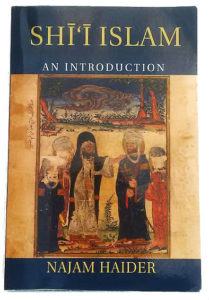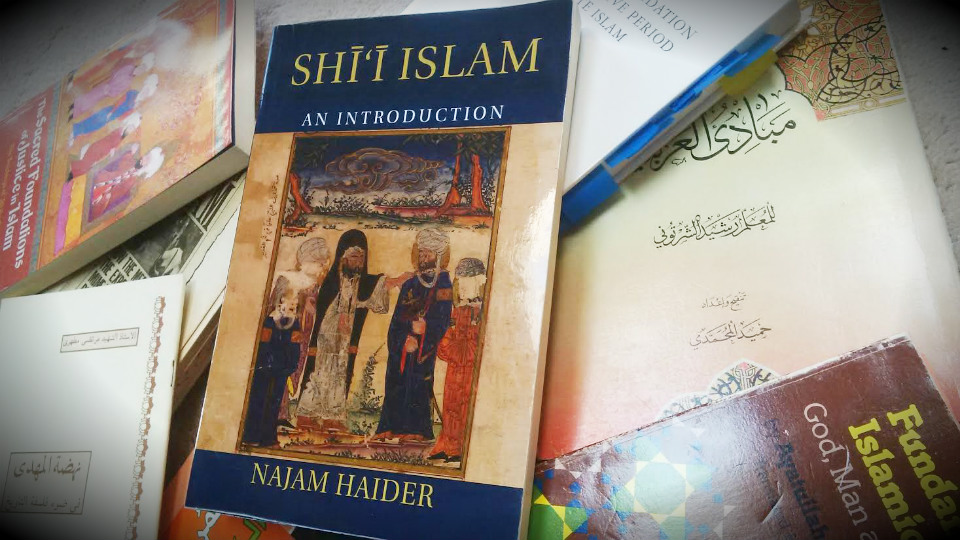Part 1 of a Summary-Review of Shīʿī Islam: An Introduction
Najam Haider’s book Shīʿī Islam: An Introduction is one of the latest additions to a growing body of academic scholarship on Shīʿī Islam. The book is unique: it is neither a typical theological primer nor a plain historical account. Many other introductory level texts are limited to theological or legal tracts without regard for historical context. Others are primarily historical and may overemphasize contentious moments in history. Haider attempts to historically situate the primary doctrines of Shīʿī Islam and the developing Shīʿī community, and explains that the development of its theology influenced the way Shīʿī Muslims remembered their past – suggesting that theology and history are intertwined. In this summary review, I present an overview of this book with special attention to the Twelver school and include comments wherever it may be useful to our community. Part one of this series will focus on the book’s introduction and its exposition of theological issues related to the concept of Divine Justice.
Shīʿī Islam as an Independent School
The introduction gives an expectation of a thoughtful account of Shīʿī Islam in contrast to Sunnī Islam, and does so without essentializing their differences or exaggerating their similarities. Haider recognizes that many works tend to present Shīʿī Islam as originating from the political controversies over the succession of the Prophet (ṣ) or focus on peripheral differences between the schools – like the issue of the placement of the hands in prayer. These works may perpetuate the misconception that Shīʿī Islam is an accident of history. They may also overlook the methodological and theological elements of Shīʿī Islam that are indicative of more than just political disagreements between groups of Muslims, and may also gloss over distinct Shīʿī trends that existed before the Prophet’s (ṣ) death. The book recognizes most of these broader elements, including their characteristic position on the nature of God and religious authority, and this helps the reader appreciate Shīʿī Islam as a relevant school of Islam that links itself to Islam’s religious heritage in a deeper way. Special attention is given to the idea of development of the school, implying an interplay of social, political, and intellectual forces at work as Shīʿī Islam expressed itself over time. It also suggests the advent of a theological consolidation close to the 10th century and speaks of rapid changes within Shīʿī scholarship and authority as the community moved towards the modern period. Later on in this piece, we will make some remarks about the possible implications of these assessments. Three groups associated with Shīʿī Islam are discussed in this book: the Twelvers, the Zaydīs, and the Ismaʿīlīs.
The Development of Shīʿī Islam

Section I begins with an introduction of modern Shīʿī theology along with a brief narrative of the historical development of these ideas during the eighth and ninth centuries onwards[1]. During this period, Shīʿī scholars engaged in intense debates with scholars from the Ashʿarī and Muʿtazilī schools. The book suggests that much of Shīʿī doctrine was formulated in light of this debate, particularly with the Muʿtazilah. In fact, by the tenth century it states the Shīʿah selectively appropriated certain principles from Muʿtazilī doctrine while rejecting other principles that conflicted with the central Shīʿī doctrine of Imāmah (translated as “legitimate leadership”). Haider admits in a footnote that this framing is oversimplified. The footnote recognizes the development of Shīʿī doctrine was certainly not a one-way appropriation by Shīʿah who simply took from the Muʿtazilah. The book states a number of Muʿtazilī theologians themselves became Shīʿī, indicating a more dynamic interplay between the two schools.[2] It may be useful to point out that the idea of Shīʿah doctrine “developing” may seem incongruous to a practicing Shīʿī audience. First, it need not be problematic if understood as a scholarly attempt to consolidate and articulate the teachings of the Qurʾān, the Ahl al-Bayt, and reason into theological form.[3] Development would then mean continuous effort to couch an eternal truth in time, in a particular type of language, alongside changing contexts, and in light of newly developing sciences. The book emphasizes the changing aspects of this development, but does not provide believers insight to the extent to which these efforts can unveil higher truths about the realities underlying Islamic beliefs, which is perhaps outside the scope of the book. Second, some Muʿtazilī scholars trace their formulations to Imām ʿAlī (a), indicating the possibility that both schools were drawing from similar inspiration in parallel.[4] Third, the book does not explore the possibility that Shīʿī scholars may have utilized formulations similar to the Muʿtazilah for the sake of debate or analysis and thus may not have viewed the formulations themselves to be fundamental to their own religious commitments.
Shīʿī Islam in Relation to the Muʿtazilah
The book characterizes the Muʿtazilah as a theological school known for emphasizing ʿaql (translated as “reason”) as paramount in theology, ethics, and Qurʾānic exegesis. It lists five core beliefs that were associated with the Muʿtazilah, which are:
- Ṭawhīd (translated as “Divine Oneness”): that the descriptions of God mentioned in the Qurʾān (g., the Face of God, the Hand of God, etc) are metaphorical and should not be interpreted in anthropomorphic terms[5]
- ‘Adl (translated as “Divine Justice”): that God is Just in a way that we can rationally understand, or in other words, God must align to a moral standard that human beings know to be correct by means of reason
- That God strictly upholds the reward of righteous believers and the punishment of sinners
- An intermediate position on grave sinners as fāsiq, who are condemned to hell but maintain their legal standing as Muslims
- The principle of enjoining good and forbidding evil, requiring Muslims to act to reform their own communities
Muʿtazilī scholars did not consider the office of Imāmah as a principle because it was not reserved for a specific divinely sanctioned lineage, with some going further to state that an imām is not necessarily required at all times.
While the Muʿtazilah criticized the Shīʿah for their positions, the book states that most of the broader Shīʿī community aligned themselves with Muʿtazilī positions, especially the Zaydiyyah who accepted nearly all of their theology (but they still restricted the office of Imāmah to the descendants of Imām ʿAlī (a)). It is said that the Twelvers affirmed the first and second, conditionally accepted the fifth, but rejected the third and fourth. The third principle left little-to-no room for intercession (shafāʿah), due to a belief that the office of Imāmah was not merely political leadership but also involved the Imām’s (and Prophet’s) role in the guidance and salvation of their loyal followers. The book states that the Twelvers rejected the fourth principle as being merely a political move to absolve certain companions of grave sins or acts of apostasy, such as waging war against Imām ʿAlī (a). It is noteworthy, that many contemporary jurists, such as Sayyid Sīstānī, hold the legal opinion that the sin of public enmity towards the Ahl al-Bayt (a) does indeed take one outside the fold of Islam if it is done by one who knows this is against Prophetic teachings.[6] As for the Ismaʿīlīs, chapter one does not say much about their relationship to these principles due to the complications of having living Imāms who had the power to change doctrine each generation.
Shīʿī Islam in Relation to Sunnī Scholars
The book accounts for another major opposition to Muʿtazilah theology among Islamic scholars: traditionists who adopted a literalist interpretation of revelation and aḥadīth and therefore “rejected the very project of theology.”[7] It goes on to state that a middle position was founded in the tenth century known as the Ashʿarī school which accepted the emphasis of the religious texts over-and-above reason, but defended these positions using rational discourse. The Ashʿarī school would eventually become the dominant position within Sunnī Islam.[8]
As an aside, readers would have benefited from a discussion on the use of the term “literalist”. The book may give one the impression that a literal interpretation is something only undertaken by traditionists. After all, recent Twelver scholars like Sayyid al-Khuʾī have explained the importance of literal (or perhaps “apparent”) meanings in texts but explain them in a way that maintains the sophistication and profundity of the revealed sources which do not limit them to mundane interpretations.[9]
Divine Justice – A Point of Contention between Schools
One of the larger contentions of Sunnī Ashʿarī scholars with the Shīʿah was over the issue of Divine Justice. As explained in chapter one, Ashʿarīs argue that God is just by definition, and so what God chooses to do, decide, command, and prohibit is what defines goodness and justice. Going further, people are not in a position to apply such labels to God since their power of reason cannot independently determine what is just and moral, whether for God or for themselves. Any attempt is speculative at best. God’s actions may not necessarily accord with a human determination of what is right or wrong, and may even flatly contradict. One must discover what is just by seeking recourse to God’s own words, found in revelation and prophetic teachings. This contrasts with the Shīʿī position. The book explains that the Shīʿah believe that God is just in a way humans can rationally understand, and therefore justice and morality are capable of being independently understood by means of reason. God’s actions must align must “accord with the basic postulates of reason”.[10] Contenders of the Shīʿah may argue that this imposes rules on God.
Divine Justice: Morality and Law
The book outlines the perspectives of both Sunnī and Shīʿī schools on morality and law. Their ethical and legal outlooks differ because how they differed on the question of Divine Justice. The book mentions that both Shīʿī and Sunnī scholars believe all people have an intrinsic human proclivity (fitrah) towards the belief in monotheism. However, Sunnīs derive ethical and legal conclusions from an engagement with revealed sources (such as the Qurʾān and aḥadith), using intellectual tools such as reason, qīyās (translated as “analogical reasoning”), and the consensus of previous expert opinions (ijmāʾ) to extract prescriptions from revealed sources. Revealed sources are central to Sunnīs. For them, reason does not have the independent power to derive ethical conclusions of its own, and must operate through the text in order to uncover ethical prescriptions.
The book is less clear on the Shīʿī perspective on morality and law. Shīʿī scholars are said to also engage with the revealed sources using reason to extract detailed prescriptions. It suggests that reason can independently grasp the existence of the correct ethical system, and is theoretically capable of ascertaining the divine purpose of laws derived from revealed sources. This is because reason can ascertain objective morality and so can recognize its correspondence in the sources. Reason therefore plays a more prominent role in ethics and in the derivation of law. The book makes a suggestive statement that Shīʿī jurists even uphold the theoretical possibility of utilizing reason alone in the derivation of legal rulings, but states that they rarely do so. The reader is not likely to glean from the book a clear picture of how this is accomplished.
At this point I would like to anticipate questions by referring to the teachings of a prominent contemporary Shīʿī theologian, Shaykh Jaʿfar Subḥānī.[11] As he elucidates, the Shīʿī position on Divine Justice does not limit the power of God nor impose upon Him external rules. Any sound determination of reason would be consonant with God not because it externally forces Him to be a certain way, but precisely because it derives from Him as part and parcel of His creation. In a manner of speaking, God’s revelation has two forms: the words of scripture, and the Divinely-inspired human nature, or fitrah. The fitrah is manifested in the human proclivity for goodness and antipathy for evil, and this manner of being grants humans a perceptive power known as reason which can recognize right and wrong. Reason and revelation together communicate the way God would want us to approach ethical decisions. To reject either one is to reject His wisdom. In the words of Shaykh Subḥānī, “reason does not impose an obligation on God, but rather unveils something from God.”[12] Haider hints at this, stating that the Shīʿī scholars “are not placing a constraint on God but merely providing an empirical description of His actions.”[13] This description can help us reconcile why it is impossible to accept that a fair God could place an infallible saint in hell for his or her many good deeds.
Second, among Shīʿī scholars is much discussion over the value and limits of reason in determining ethical prescriptions independently of revelation. It is clear, however, that good and evil are said to be intelligible at least in a general way and we do not need revelation to confirm this.[14] This opinion would suggest that normal people are not capable of determining the precise details of all fair and unjust acts, but are capable of knowing the basic postulates of reason that clearly reveal injustice as generally wrong and God as just. And so, for example, any person or idea that encourages wholesale genocide of innocents could be ruled out immediately on this basis. Revealed sources would thereafter play an important role in explicating the details of a truthful religion which would be inaccessible to reason alone. Traditions speak of this dual-natured guidance, reason being an inner proof and prophetic guidance being an outer proof.[15]
Third, some argue that reason is supposed to lead all people to the same conclusions since it is a universal human faculty, and so the existence of debate is evidence enough that it has no such ability to independently arrive at moral truths. A response given is that not all determinations of reason are alike. Some are self-evident while others require contemplation and the blossoming of the intellect. This is perhaps why some people do not recognize certain rational principles as others do; hence the disagreement.[16] Finally, some have problematized the issue further by pointing out paradoxes in ethics; for example, lying may sometimes be justified in order to save a large number of people from a tyrant. If reason understands both lying and murder as wrong, what apart from revealed sources could arbitrate this moral dilemma? Reason comes to our aid once again; it independently understands that although lying and murder are evil, a lie compared to a pending mass-murder is certainly less evil.[17]
The Implications of Divine Justice on the rest of Shīʿī Theology
Moving onward, the book links the Shīʿī position on Divine Justice to their peculiar perspectives on free will, the existence of evil, Imāmah, and social justice.
Divine Justice Implies Free Will
Although practical and experiential reasons are posited for assenting to the idea that humans enjoy freedom in their actions, the Shīʿī scholars also believe that reason can perceive the tyranny or capriciousness of a God who compels our actions yet holds us accountable. Shīʿī scholars support this position by recourse to Qurʾānic verses that confirm our ability to choose between right and wrong. Other verses that appear to imply a divinely appointed destiny for people are given philosophical interpretations which reconcile the decrees (qadā’) and determinations (qadar) of God with free will.
Reconciling Divine Justice with Evil
The doctrine of Divine Justice made it difficult to resolve the apparent paradoxes of evil in a world created by a merciful, good God. The book suggests that Shīʿī scholars refused to ascribe evil to God, despite His absolute control over every created thing, and attempted to resolve this difficulty in three ways. First, evil is a necessary corollary of the material world, and the existence of a world with some evil in it means that it must have a greater purpose. Second, a substantial amount of evil in the world is a consequence of human free-will (e.g. oppression by tyrants) which as mentioned before is a necessary part of our existence, but absolves God of the moral responsibility of evil human behavior and requires moral agents to rectify such evil (the practical application of these efforts varied with the different Shīʿī schools, but all recognized the Imām at the helm). Third, from a philosophical perspective, evil is actually non-existential and takes place where God’s will is absent, like a shadow which is simply the absence of sunlight.
Reconciling Divine Power with Free-will and Evil
The book moves on to explain the supposed inconsistency between an omnipotent God with free-will and evil. Both appear to imply that God is not in control of human action. The book does not resolve this difficulty directly, but makes an association between this paradox and another well-known problem where God is tasked to create an illogical creature or one He cannot overcome, like a 5-sided triangle or an immovable rock. Shaykh Jaʿfar Subḥānī clarifies that God’s infinite power extends to all possible beings, while impossible beings are so deficient and limited as to not be capable of accepting God’s grace to exist.[18] So the limitation is not with God, but to that which is incapable of receiving God’s grace. As Imām ʿAlī (a) states, “God has no connection with incapacity, so that about which you asked about (ie, impossible beings) cannot be.”[19] The book does not rigorously engage with the possibility of a world without evil, or whether such a world would be a better one, although Shīʿī scholars have done so in the past.
The Sunnī opinion on both free-will and evil is presented by the book as contradictory: they uphold predestination in theory while simultaneously acknowledging the Qurʾānic verses that imply free-will. There is apparently no need to resolve this difficulty since reason is not necessarily in a position to independently grasp an explanation. Sunnīs did develop concepts like kasb which reconciled a form of human agency with God’s omnipotence, but the details are not presented in the book. Sunnīs also discussed theodicy and evil by referencing revealed sources. This appears not to be an attempt to resolve rational contradictions in theology but rather to explore religious sources for guidance.
Divine Justice implies Imāmah
Shīʿī doctrine holds that one of the central consequences of Divine Justice is the belief in luṭf (grace), whereby God acts in humanity’s best interests. Prophethood is therefore predicated on the principle of God’s grace, delivering to humanity essential guidance that most if not all human beings could not have understood on their own. The Shīʿah take this principle a step further arguing for the need of proper interpretation of the Prophet’s revelation, and hence the need for an Imām to preserve the truth in its correct form. A few more distinctive theological beliefs unfold thereafter, including the Twelver and Ismaʿīlī belief in Imāmah and ‘isma (infallibility) of the divinely appointed personalities who are responsible for infallibly conveying and preserving the divine message. The Zaydiyyah do not go so far and believe instead that human reason is sufficient for grasping at a proper interpretation of revelation and concentrate instead on Imāmah’s political and social aspects.
Shīʿī Islam and the Qurʾān
As a final comment, the book’s theological account lacks a serious treatment of the Shīʿī relationship to the Qurʾān. The reader may be left with the impression that Shīʿī Islam does not center itself around Islam’s divine text nor have its own exegetical perspectives. The book focuses on its role in clarifying ethical prescriptions and law along with providing supporting evidence for doctrine. We believe mainstream Shīʿī Islam recognizes both the Qurʾān and Imāmah as two foundational sources for orienting believers towards a comprehensive Islamic worldview, as is suggested by the famous Hadīth al-Thaqalayn, and this would have been worthwhile to explore further due to the misconception that the Shīʿah underemphasize the Qurʾān and overemphasize Imāmah.[20]
Conclusion
Shīʿī Islam: An Introduction is a well rounded primer to Shīʿī Islam. Its first section takes the reader through the distinctive theological positions of modern Shīʿī Islam, tracing their roots to the historical debates with other schools of theology. The book avoids certain pitfalls common to other introductory level books by recognizing this school as theologically distinctive rather than merely politically charged, having its own unique approach to Islam. It also makes bold claims regarding the development of Shīʿī theology as something of an appropriation of Muʿtazilah thought, although we shared an alternative perspective where Shīʿī scholarship ran parallel, but in conversation, with Muʿtazilah scholars who share similar inspirations and sources of knowledge. The book places special emphasis on the historical development of Shīʿī theology, but we suggested the need for more explanation and nuance in describing how theological developments can relate to primordial Islamic truths. Finally, Shīʿī approaches to fundamental theological issues lead to distinctive perspectives on human reason, ethics, exegesis, and doctrine. The most well-known consequence of Divine Justice is the Institution of Imāmah, the cornerstone of Shīʿī theology. In part two we hope to explore the book in further detail, focusing on its characterization of Imāmah.
[1] The adjective “modern” is used because the author suggests that the earlier Shīʿī community may not have articulated these doctrines or presented them in the way familiar to the later Shīʿī community.
[2] For a treatment of one such scholar, ibn Qiba, please refer to Hossein Modarressi’s Crisis and Consolidation Crisis and Consolidation in the Formative Period of Shīʿite Islam: Abū Jaʿfar ibn Qiba al-Rāzī and His Contribution to Imāmite Shīʿite Thought.
[3] Murtaẓa Mutahharī states in Introduction to Ilm al-Kalam: “…’ilm al-kalam, like any other field of study, developed gradually and slowly attained maturity.”
[4] Muḥammad Riḍa Jaʿfarī in the chapter “The beliefs of the Imamiyyah” in An Introduction to the Emendation of A Shi‘ite Creed (http://www.al-islam.org/introduction-emendation-shiite-creed-muhammad-rida-jafari), wrote, “…it is enough to point out that al-Ka‘bi al-Balkhi, the Qadi ‘Abdu ‘l-Jabbar, Ibnu ‘l-Murtada and Nashwan al-Himyari trace the origin of the Mu‘tazilah School, with respect to Justice and Unicity, to the Commander of the Faithful…” His various sources can be found in his footnote.
[5] In addition to what is stated by Haider in the book, the Muʿtazilah held that the Divine attributes are not distinct from God’s essence—that is, God’s Being is not distinct from His Mercy, Power, Knowledge, etc.
[6] ʿAli Husaynī Sīstānī, al-Masāʾil al-Muntakhabah, (Maktab Samāḥat al-Sayyid Āyat Allāh al-ʿuẓmā al-Sayyid al-Sīstānī), 86.
[7] Najam Haider, Shīʿī Islam: An Introduction, (NY: Cambridge University Press, 2014), 15.
[8] Although Ashʿarī theology was at one time dominant in Sunnī Islam, in recent times it has been challenged by Modernist and Salafī conceptions of theology.
[9] al-Sayyid Abū al-Qāsim al-Khuʾī, Zawahir al-Qur’an: The Authority of the Book’s Literal Meanings, trans. Mujahid Husayn, http://www.al-islam.org/al-tawhid/general-al-tawhid/zawahir-al-quran-authority-books-literal-meanings.
[10] Najam Haider, Shīʿī Islam: An Introduction, (NY: Cambridge University Press, 2014), 18.
[11] Sayyid Sulayman Hassan, “Kalām Lecture based on Muḥāḍarāt fī al-ilāhiyyāt li-Samāḥat al-ʻAllāmah al-Muḥaqqiq Jaʻfar al-Subḥānī” (class, Ahl al-Bayt Islamic Seminary, March 1, 2015).
[12] Alī Rabbānī Gulpāyigānī, Muḥāḍarāt fī al-ilāhīyāt li-Samāḥat al-ʻAllāmah al-Muḥaqqiq Jaʻfar al-Subḥānī, (Qum: Muʼassasat al-Imām al-Ṣādiq, 1421).
[13] Najam Haider, Shīʿī Islam: An Introduction, (NY: Cambridge University Press, 2014), 25.
[14] Jaʿfar Subḥānī, trans. Reza-Shah Kazemi, Doctrines of Shiʿi Islam, (London: I.B. Tauris, 2001), 50.
[15] Muḥammad ibn Yaʿqub al-Kulayni, trans. Rizwan Arastu, al‑Kāfī: Book One: Book of Intellect and Foolishness, (Monmouth Junction, NJ: Taqwa Media, 2012), 77.
[16] Sayyid Sulayman Hassan, “Kalām Lecture based on Muḥāḍarāt fī al-ilāhiyyāt li-Samāḥat al-ʻAllāmah al-Muḥaqqiq Jaʻfar al-Subḥānī” (class, Ahl al-Bayt Islamic Seminary, April 5, 2015).
[17] Sayyid Sulayman Hassan, “Kalām Lecture based on Muḥāḍarāt fī al-ilāhiyyāt li-Samāḥat al-ʻAllāmah al-Muḥaqqiq Jaʻfar al-Subḥānī” (class, Ahl al-Bayt Islamic Seminary, April 5, 2015).
[18] Jaʿfar Subḥānī, trans. Reza-Shah Kazemi, Doctrines of Shiʿi Islam, (London: I.B. Tauris, 2001), 36.
[19] Jaʿfar Subḥānī, trans. Reza-Shah Kazemi, Doctrines of Shiʿi Islam, (London: I.B. Tauris, 2001), 37.
[20] “The Prophet has said, ‘I leave among you two facts, if you hold to them firmly, you will never be misled: the Book of Allah, the most Holy, the most High, and my family…”, in Muhammad Sarwar’s translation of al-Kāfī (NY: Islamic Seminary Inc., 2014) .




